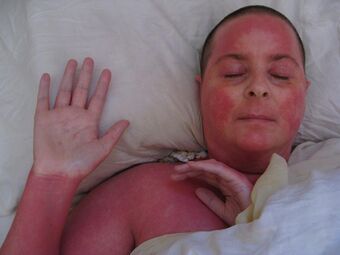Medicine:Red burning skin
Red burning skin, also known as topical steroid addiction and steroid dermatitis, has been reported in long-term users of topical steroids.[1][2] It generally requires the application of a topical steroid at least daily for more than a year.[3] It has already been described in adults.[3] It appears to be a specific adverse effect of steroid use.[4] Atopics are most at risk.[5]
Signs and symptoms
TSA is characterised by uncontrollable, spreading dermatitis and worsening skin inflammation which requires a stronger topical steroid to get the same result as the first prescription. When topical steroid medication is stopped, the skin experiences redness, burning, itching, hot skin, swelling, and/or oozing for a length of time. This is also called 'red skin syndrome' or 'topical steroid withdrawal' (TSW). After the withdrawal period is over the atopic dermatitis can cease or is less severe than it was before.[6]
Duration
The duration of acute topical corticosteroid withdrawal is variable, it can take months to years to return to the skin's original condition.[7] The duration of steroid use may influence the recovery factor time, with the patient's who used steroids for the longest reporting the slowest recovery.
Mechanism of action
Historically, it was believed that cortisol was only produced by the adrenal glands. Recent research has shown that keratinocytes in human skin also produce cortisol.[8] Prolonged TS application changes the glucocorticoid receptor (GR) expression pattern on the surface of lymphocytes; patients experiencing resistance to TSs have a low ratio of GR-α to GR-β. In addition, the erythema characteristic of ‘‘red skin syndrome’’ is due to a release of stored endothelial nitric oxide (NO) and subsequent vasodilation of dermal vessels.[9]
History
The first description of the condition occurred in 1979.[10]
References
- ↑ Nnoruka, Edith; Daramola, Olaniyi; Ike, Samuel (2007). "Misuse and abuse of topical steroids: implications.". Expert Review of Dermatology 2 (1): 31–40. doi:10.1586/17469872.2.1.31. https://drive.google.com/file/d/0B1-8beVOpbT8ZWh5Q09NakxDNlk/edit. Retrieved 2014-12-18.
- ↑ Sanjay, Rathi; D'Souza, Paschal (2012). "Rational and ethical use of topical corticosteroids based on safety and efficacy.". Indian Journal of Dermatology 57 (4): 251–259. doi:10.4103/0019-5154.97655.
- ↑ 3.0 3.1 "Topical corticosteroid withdrawal". http://www.dermnetnz.org/reactions/topical-steroid-withdrawal.html. Retrieved 19 July 2016.
- ↑ Hajar, T; Leshem, YA; Hanifin, JM; Nedorost, ST; Lio, PA; Paller, AS; Block, J; Simpson, EL et al. (March 2015). "A systematic review of topical corticosteroid withdrawal ("steroid addiction") in patients with atopic dermatitis and other dermatoses.". Journal of the American Academy of Dermatology 72 (3): 541–549.e2. doi:10.1016/j.jaad.2014.11.024. PMID 25592622.
- ↑ Sheary, BMed, FRACGP, General Practitioner, Belinda. "Topical corticosteroid addiction and withdrawal – An overview for GPs". Australian Family Physician. https://www.racgp.org.au/afp/2016/june/topical-corticosteroid-addiction-and-withdrawal-%E2%80%93-an-overview-for-gps/.
- ↑ Fukaya, M; Sato, K; Sato, M; Kimata, H; Fujisawa, S; Dozono, H; Yoshizawa, J; Minaguchi, S (2014). "Topical steroid addiction in atopic dermatitis.". Drug, Healthcare and Patient Safety 6: 131–8. doi:10.2147/dhps.s69201. PMID 25378953.
- ↑ Oakley, M.D., Amanda. "Topical corticosteroid withdrawal". DermNet New Zealand Trust. http://www.dermnetnz.org/reactions/topical-steroid-withdrawal.html.
- ↑ Cirillo, N; Prime, S (2011). "Keratinocytes synthesize and activate cortisol.". Journal of Cellular Biochemistry 112: 1499–505. doi:10.1002/jcb.23081. PMID 21344493.
- ↑ Juhász, MLW; Curley, RA; Rasmussen, A; Malakouti, M; Silverberg, N; Jacob, E (September–October 2017). "Systematic review of the topical steroid addiction and topical steroid withdrawal phenomenon in children diagnosed with atopic dermatitis and treated with topical corticosteroids.". Journal of the Dermatology Nurses’ Association 9 (5): 233–240. doi:10.1097/JDN.0000000000000331. PMID 21344493.
- ↑ Topical corticosteroid addiction and withdrawal – An overview for GPs. Jun 2016. http://www.racgp.org.au/afp/2016/june/topical-corticosteroid-addiction-and-withdrawal-%E2%80%93-an-overview-for-gps/. Retrieved 23 July 2016.




